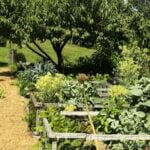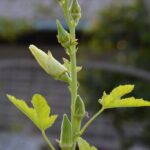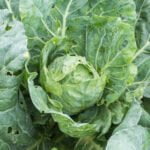Vegetable gardening is a popular hobby for many individuals and families, providing not only the opportunity to grow their own nutritious produce but also the satisfaction of cultivating a beautiful garden. One crucial aspect of successful vegetable gardening is choosing the right materials, including the type of wood used for raised beds or garden structures.
In recent years, cedar wood has gained attention as a potential choice for vegetable gardens due to its unique properties and benefits. In this article, we will explore the pros and cons of using cedar wood in vegetable gardens, allowing you to make an informed decision about whether it is the right choice for your own growing endeavors.
To understand why cedar wood is being considered as a suitable material for vegetable gardens, it is essential to delve into its properties and advantages. Cedar wood boasts several qualities that make it beneficial for growing vegetables. Firstly, it possesses natural resistance against insects and rot, reducing the need for chemical treatments while protecting plants from potential threats.
Additionally, cedar wood can enhance soil quality by promoting healthy drainage and minimizing compaction issues commonly seen in other types of woods. Moreover, cedar wood’s aromatic characteristics are said to have potential pest-repelling properties, creating a more favorable environment for vegetable growth.
While there are numerous benefits associated with using cedar wood in vegetable gardens, it is important to examine any potential drawbacks or risks as well. Some concerns include the initial cost of purchasing cedar wood materials compared to other options and its longevity and durability over time.
Furthermore, environmental considerations should be taken into account when deciding whether to use cedar wood due to issues surrounding sustainability. By exploring both sides of the argument and weighing these factors carefully, you can determine if this popular choice is indeed ideal for your vegetable garden.
Understanding the Properties of Cedar Wood
Cedar wood is a popular choice for many gardeners when it comes to constructing raised beds or planting containers for their vegetable gardens. Understanding the properties of cedar wood can help gardeners make an informed decision about whether or not to use it in their own vegetable gardens.
The Benefits of Cedar Wood for Growing Vegetables
One of the main benefits of cedar wood is its natural resistance to insects and rot. Cedar contains natural oils and compounds that act as insect repellents, making it less likely for pests to invade your vegetable garden. This can be especially beneficial for organic gardeners who prefer to avoid using chemical pesticides.
In addition, cedar wood has a long lifespan compared to other types of wood commonly used in gardening. It is naturally durable and resistant to decay, which means that it can withstand the outdoor elements for many years without deteriorating. This longevity makes cedar wood a sustainable choice for those looking to establish a long-term vegetable garden.
Enhancing Soil Quality with Cedar Wood
Another advantage of using cedar wood in vegetable gardens is its ability to enhance soil quality. As cedar ages and weathers, it releases natural oils into the surrounding soil. These oils contain beneficial compounds such as thujaplicin, which have antimicrobial properties and can help suppress harmful pathogens in the soil.
Furthermore, cedar wood has a low pH level, making it slightly acidic. This acidity can benefit acid-loving plants such as blueberries or tomatoes, which thrive in acidic soil conditions. However, it’s important to note that while this characteristic may be advantageous for some plants, it may not be suitable for all types of vegetables.
Overall, understanding the properties of cedar wood provides valuable insights into its benefits for growing vegetables. From its natural resistance to insects and rot to its ability to enhance soil quality, cedar wood offers a range of advantages that make it an appealing option for many gardeners. However, it’s important to weigh these benefits against the potential drawbacks and consider your specific gardening needs before making a decision.
The Natural Resistance
Repelling Insects with Cedar Wood
One of the significant benefits of using cedar wood in vegetable gardens is its natural ability to repel insects. Cedar contains natural oils that give it a distinct aroma, which acts as a deterrent for many common garden pests. The scent of cedar is particularly effective against ants, moths, termites, and beetles. It can also help keep away aphids, slugs, and other insects that can damage your vegetables.
Cedar’s insect-repellent properties are especially beneficial when used in raised beds or containers. By constructing your garden beds out of cedar wood, you create a barrier against crawling insects that may try to access your plants from the ground. Additionally, lining the inside walls of your containers with cedar boards can provide added protection. This natural resistance reduces the need for chemical insecticides and promotes organic gardening practices.
Rot Resistance: How Cedar Wood Preserves Your Garden
Another advantage of cedar wood is its exceptional resistance to rot and decay. The inherent properties of cedar make it highly resistant to moisture-related issues that can damage vegetable gardens over time. Rot-resistant wood ensures that your garden bed or container will maintain its structural integrity for an extended period.
The durability of cedar against rot extends the lifespan of your vegetable garden infrastructure. By choosing cedar wood for raised beds or containers, you are investing in a long-term solution that requires minimal maintenance. This not only saves you money but also prevents the need for frequent replacements.
In addition to preserving the overall structure, the rot resistance of cedar wood helps protect your plants as well. By keeping moisture levels in check and preventing rot from spreading, you ensure the health and longevity of your garden’s root systems. With healthier roots, your vegetables are better equipped to withstand environmental stresses and produce higher yields.
By utilizing the natural resistance properties of cedar wood in your vegetable garden, you can safeguard your plants from destructive insects and preserve the integrity of your garden infrastructure.
Creating a Healthy Environment
Cedar wood not only adds beauty and durability to your vegetable garden, but it can also enhance the soil quality, creating a healthy environment for your plants to thrive.
One of the key benefits of using cedar wood in your vegetable garden is its natural ability to resist decay and decomposition. This means that even when exposed to moisture, cedar wood will retain its structure and integrity for a longer period of time compared to other types of wood. As a result, you can expect your raised beds or planter boxes made from cedar wood to last for many years without the need for frequent replacement.
In addition to its durability, cedar wood also has the unique ability to balance soil moisture levels. It acts as a natural moisture regulator by absorbing excess moisture from the soil during wet periods and releasing it back when the soil becomes dry. This helps prevent waterlogging and promotes proper drainage, which is essential for maintaining healthy root systems in vegetable gardens.
Moreover, the use of cedar wood can enhance nutrient retention in the soil. Cedar contains natural oils and resins that slowly break down over time, releasing beneficial organic compounds into the soil. These compounds contribute to improved nutrient availability, promoting better growth and development of your vegetables.
To take full advantage of cedar wood’s ability to enhance soil quality in your vegetable garden, consider incorporating raised beds or planter boxes made from this type of wood. The elevated nature of raised beds improves drainage and prevents compaction, while the cedar wood helps maintain optimal moisture levels and provides nutrients to your plants. Additionally, lining pathways with cedar wood chips or mulch can further enrich the soil over time as these organic materials decompose.
By utilizing cedar wood in your vegetable garden design and maintenance strategies, you can create a healthy environment that supports robust plant growth and maximizes productivity.
The Aromatic Advantage
One of the significant benefits of using cedar wood in vegetable gardens is its potential to repel pests. Cedar wood contains natural oils and compounds that produce a distinct aroma that many insects find unpleasant or even toxic. This aromatic advantage can help protect your garden from various pests, reducing the need for chemical pesticides.
Cedar wood’s pest-repelling properties are particularly effective against common garden pests such as ants, termites, moths, and mosquitoes. The scent emitted by cedar wood acts as a natural deterrent, preventing these insects from entering your garden or causing damage to your plants. By incorporating cedar wood into your garden design, you can create a barrier that keeps unwanted pests at bay.
In addition to acting as a deterrent, research suggests that certain compounds found in cedar wood may have insecticidal properties. For example, the compound known as thujone has been shown to have insect-repellent effects on various pests. This natural protection allows you to maintain a healthier and more sustainable garden without resorting to harsh chemicals.
However, it’s important to note that while cedar wood can be effective in repelling pests, it may not guarantee complete pest control. Some types of insects may still be attracted to certain plants or find other ways to access your garden despite the presence of cedar wood. Therefore, it is recommended to use cedar wood in conjunction with other integrated pest management strategies for maximum effectiveness.
By harnessing the aromatic advantage of cedar wood in your vegetable garden, you can benefit from its potential pest-repelling properties. This natural approach not only helps protect your plants but also promotes a healthier ecosystem within your garden by minimizing the use of harmful pesticides. Consider incorporating cedar wood structures or mulch into your vegetable garden design to take advantage of this beneficial property and enjoy a pest-free gardening experience.
Longevity and Durability
Cedar wood is not only aesthetically pleasing but also known for its longevity and durability, making it an excellent choice for maintaining a sustainable vegetable garden. The natural properties of cedar make it resistant to rot, decay, and insect damage, ensuring that your vegetable garden structures will last for years to come.
One of the key benefits of using cedar wood in your vegetable garden is its ability to withstand the elements. Unlike other types of wood that may deteriorate over time, cedar naturally repels moisture and resists rotting. This means that your raised beds, trellises, and other structures made from cedar will remain intact and functional for many growing seasons.
Not only does cedar wood offer durability, but it also contributes to the sustainability of your garden. Cedar is a renewable resource and when sourced responsibly, can be an eco-friendly option for gardeners. By choosing to build your vegetable garden structures with cedar wood, you are reducing the need for synthetic materials that have a negative impact on the environment.
To maximize the longevity and durability of cedar wood in your vegetable garden, there are some best practices to keep in mind:
- Choose quality cedar wood: Opt for high-grade cedar that is free from knots or defects. This ensures that your structures are strong and less prone to damage.
- Apply protective finishes: Applying a protective finish like linseed oil or exterior sealant can further enhance the durability of cedar wood by providing an extra layer of protection against moisture.
- Properly maintain your structures: Regularly inspecting and maintaining your cedar wood structures can help prevent any potential issues such as loose boards or signs of rot.
Potential Concerns
Cedar wood is known for its numerous benefits in vegetable gardens, but it’s important to also understand and address any potential concerns or risks associated with its use. While cedar wood can be a great addition to your garden, there are a few drawbacks that should be considered.
One concern with cedar wood is its natural scent. While some people find the aroma of cedar pleasant, others may find it overpowering. The strong smell of cedar can linger in the garden and potentially affect the taste and smell of vegetables. It’s important to take this into consideration if you have sensitive taste buds or if you plan on using your vegetables for culinary purposes.
Another potential drawback of cedar wood is its cost. Cedar wood can be more expensive than other types of woods commonly used in gardens such as pine or fir. This higher cost may not be feasible for everyone, especially those on a tight budget. It’s important to consider your budget and weigh the benefits of cedar wood against its cost before making a decision.
In addition to the concerns mentioned above, it’s crucial to properly maintain and treat cedar wood to prolong its lifespan. Cedar naturally contains oils that help protect it from rot and decay, but over time these oils can diminish, leaving the wood vulnerable to damage. Regularly treating the cedar wood with sealants or stains can help maintain its longevity and durability.
When considering the drawbacks and risks associated with cedar wood in vegetable gardens, it’s essential to weigh them against the many benefits that cedar offers. These include its natural resistance to insects and rot, ability to enhance soil quality, and potential pest-repelling properties. As long as proper precautions are taken and regular maintenance is done, using cedar wood in your vegetable garden can be a successful choice.
| Potential Concerns | Risks |
|---|---|
| Natural scent | Potential effect on taste and smell of vegetables |
| Cost | Higher than other types of woods commonly used in gardens |
| Maintenance and treatment | Regular treatment needed to maintain longevity and durability |
Tips for Using Cedar Wood in Your Vegetable Garden
Using cedar wood in your vegetable garden can provide numerous benefits, but it is important to follow certain tips and best practices to ensure success. Here are some guidelines to help you make the most of your cedar wood garden beds:
- Choose the Right Type of Cedar: When selecting cedar wood for your vegetable garden, opt for rot-resistant varieties such as Western red cedar or Eastern white cedar. These types of cedar have natural oils and compounds that make them more resistant to decay and insect damage, ensuring the longevity of your garden beds.
- Use Untreated Cedar: It is crucial to use untreated cedar wood in your vegetable garden. Treated wood contains chemicals that can leach into the soil and be absorbed by your plants, potentially contaminating them with harmful substances. Untreated cedar is a safe and natural option that will not compromise the health of your vegetables.
- Line Your Garden Beds: To further protect your vegetables and extend the lifespan of your cedar wood, consider lining the inside of your garden beds with a barrier or plastic sheeting. This will prevent direct contact between the soil and the wood, reducing moisture absorption and potential rot.
- Plan for Proper Drainage: Ensure adequate drainage in your garden beds by creating a layer of gravel or small rocks at the bottom before filling them with soil. This will help prevent water from pooling at the bottom and causing waterlogged conditions that could lead to rot.
Overall, using cedar wood in your vegetable garden can enhance its sustainability and productivity. By following these tips and best practices, you can ensure that your cedar wood garden beds thrive while providing a healthy environment for your plants.
| Tips | Best Practices |
|---|---|
| Choose rot-resistant varieties | Use Western red cedar or Eastern white cedar |
| Use untreated cedar | Avoid chemicals leaching into soil and plants |
| Line garden beds | Prevent direct contact with soil and reduce rot |
| Create proper drainage | Add layer of gravel or rocks to prevent waterlogging |
Environmental Considerations
When deciding whether to use cedar wood in your vegetable garden, it is important to consider the environmental impact of this choice. Cedar wood is known for its sustainability and eco-friendliness, making it a popular option among gardeners.
One of the main reasons why cedar wood is considered sustainable is because it is a renewable resource. Unlike other types of wood that require extensive logging and often result in deforestation, cedar trees are harvested responsibly. Sustainable forestry practices ensure that new trees are planted to replace those that are cut down, maintaining the overall health and longevity of the cedar forests.
Additionally, cedar wood requires minimal processing before it can be used in vegetable gardens. This means that fewer chemicals and energy are needed during production compared to other materials. By choosing cedar wood, you can reduce your environmental footprint and contribute to more sustainable gardening practices.
Furthermore, using cedar wood in your vegetable garden can have positive effects on soil quality and fertility. Cedar naturally contains compounds called thujaplicins, which have antimicrobial properties that can help suppress harmful fungi and bacteria in the soil. This can lead to healthier plant growth and less reliance on chemical fertilizers or pesticides.
Overall, when considering the sustainability of using cedar wood in your vegetable garden, it is clear that this material offers several environmentally friendly benefits. From its renewable nature to its ability to enhance soil quality, cedar wood provides a sustainable option for gardeners who want to minimize their impact on the environment while growing healthy vegetables.
Conclusion
In conclusion, when deciding whether cedar wood is the right choice for your vegetable garden, it is important to weigh the pros and cons of using this material. Cedar wood offers numerous benefits for growing vegetables, such as its natural resistance to insects and rot, its ability to enhance soil quality, and its potential pest-repelling properties. Additionally, cedar wood is known for its longevity and durability, making it a sustainable option for maintaining a healthy garden.
However, it is essential to also consider the potential drawbacks and risks associated with cedar wood. While it may naturally repel pests, some gardeners have reported that it can attract certain types of insects as well.
There are concerns about the use of pressure-treated cedar wood containing toxic chemicals that could potentially leach into the soil and affect plant growth. It is crucial to carefully research and choose untreated or naturally decay-resistant varieties of cedar wood if you decide to use it in your vegetable garden.
When using cedar wood in your vegetable garden, there are a few best practices to keep in mind. Properly prepare the soil before planting by incorporating organic matter to further enhance fertility. Consider applying a natural sealant or oil treatment on the cedar wood to lengthen its lifespan and maintain its appearance over time. Regularly monitor your garden for any signs of pests or diseases to address them promptly and prevent any potential damage.
Lastly, environmentally conscious gardeners should consider the sustainability aspect of using cedar wood in their vegetable gardens. Cedar trees are slow-growing species that can take decades to mature fully. Therefore, it is important to source cedar wood from sustainably managed forests or consider alternatives that have less impact on the environment.
Ultimately, deciding whether cedar wood is the right choice for your vegetable garden depends on your specific needs and preferences as a gardener. By carefully considering both the benefits and potential concerns associated with cedar wood, you can make an informed decision that will lead to a thriving and sustainable vegetable garden.
Frequently Asked Questions
Is cedar wood safe for vegetable gardens?
Cedar wood is generally safe for vegetable gardens. Unlike some other types of wood, cedar contains natural oils and compounds that make it resistant to decay and insect damage. These properties help protect the plants in the garden from potential harmful substances leaching into the soil.
However, it’s important to note that not all cedar wood products are created equal, as some may be treated with chemicals or additives that could pose a risk to the garden. It’s always best to choose untreated or naturally preserved cedar wood for vegetable garden projects.
Can you use cedar wood for raised garden beds?
Yes, cedar wood is an excellent choice for raised garden beds. Its natural durability and resistance to rot make it a long-lasting option for constructing raised beds.
Cedar also has the advantage of being lightweight while still maintaining strength, making it easier to transport and assemble compared to heavier alternatives such as concrete or stone. Additionally, the attractive appearance of cedar adds a touch of beauty to any garden bed, enhancing the overall aesthetic appeal of your outdoor space.
How long does untreated cedar last for a garden bed?
Untreated cedar can last anywhere from 10-20 years when used for a garden bed, depending on various factors such as climate conditions and maintenance practices. The natural oils present in cedar wood act as a barrier against rot and decay, extending its lifespan compared to other types of untreated wood commonly used for garden beds.
Over time, however, weathering and exposure to moisture will gradually break down the wood fibers, diminishing its structural integrity. To maximize the lifespan of an untreated cedar garden bed, regular maintenance such as sealing or staining may be necessary to protect it from excess moisture and UV damage caused by sunlight exposure

If you’re looking to get into vegetable gardening, or are just looking for some tips on how to make your current garden better, then you’ve come to the right place! My name is Ethel and I have been gardening for years. In this blog, I’m going to share with you some of my best tips on how to create a successful vegetable garden.





